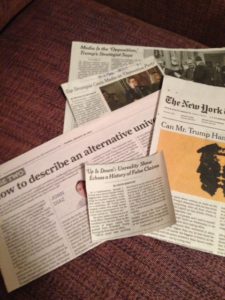 Although fake news was barely a blip on the screen prior to 2016, it already existed in abundance. Following the November election, many questions have been raised about the influence of fake news. Not only had an important election been at stake, but also the credibility of what we read and how we perceive it.
Although fake news was barely a blip on the screen prior to 2016, it already existed in abundance. Following the November election, many questions have been raised about the influence of fake news. Not only had an important election been at stake, but also the credibility of what we read and how we perceive it.
Fake news has now become a major topic of discussion. Not a day goes by that mainstream media does not shine light on a questionable statement, including “alternative facts.”
The President and his team refer to the mainstream media as “dishonest.” A senior White House strategist recently referred to the media as “the opposition party.” “The media should … keep its mouth shut and just listen for a while.”
So, what is a person to believe? And what about all of those fake news sites that look real but are completely bogus?
“Lies and misinformation on the Internet have become a focal point for many in post-election America,” said reporter Melissa Lang of the San Francisco Chronicle. “Companies, people and media organizations grapple with the fast-spreading falsehoods on discourse and politics.”
Lang goes on to cite a study by researchers at Ohio State University that hyper-partisan information is more likely to fall in the category of fake news. Companies like Facebook and Google, trying to combat this, are hiring researchers to weed out false information.
Fake news, no doubt, is causing confusion. A recent study by Pew Research Center reveals that 23% of Americans have shared fake news, either knowingly or unknowingly. “Americans express a fair amount of confidence in their own ability to detect fake news, with about four-in-ten (39%) feeling very confident that they can recognize news that is fabricated and another 45% feeling somewhat confident.”
But reality would indicate that the problem is widespread and hard to address. Sticking to the facts is helpful, if one knows what the facts really are.
Mainstream media is obligated to fact check their stories. If the same story appears in multiple mainstream sources, there is a good chance that it is true.
The news media has clearly caught on that people are concerned about fake news sites. A recent ad from Vanity Fair advises the reader to “Fight back with style..with wit..with insight..with unfake news. Subscribe now.” The New York Times suggests “No alternatives. Just Facts. Enjoy 40% off before our sale ends soon.” GQ tells us to “Connect with GQ. Do not participate in the … propaganda game.”
Public libraries are good sources when it comes to discerning truth from falsehood. Reference librarian Sally Ijams of the Darien Public Library (CT) recently made a presentation on fake news. “Be cautious with clickbait,” she advised a packed library meeting room. Be wary of excessive punctuation; beware of news that is too good, too weird or too reactionary to be true; beware of websites that lack contact information.
Additional tips from Ijams:
- Fake news relies on appealing to emotions. Be wary of headlines designed to make you angry, especially those written in all caps.
- Watch for websites that end in .com.co and fake versions of real news sources. Domain sources that end in .com, .edu or .org are more likely to be real news, but this is not a guarantee.
- Fact checking websites help clarify the veracity of a source. Ijams recommends FactCheck.org, which is affiliated with the Annenberg Public Policy Center; Snopes.com, which she refers to as “the first, the oldest and the best;” and Politifact.com and RetractionWatch.com.
Like most people, I have my favorite news sites: The New York Times, San Francisco Chronicle, the Washington Post and NPR. Other sites that I trust include Reuters, The Wall Street Journal, CNN, CBS, USA Today and Associated Press. I enjoy news and commentary by Dan Rather on his site, News and Guts. I feel strongly that we should support the media, especially while it is under attack.
I also have made a vow to tune into other media with different points of view, such as Fox News, and hope I have the wisdom and tools to differentiate between what is real and what is fake news
Sources (selected)
“Many Americans Believe Fake News is Sowing Confusion.” Pew Research Center, Dec. 15, 2016
“Battling fake news, Facebook adjusts trending topics,” by Marissa Lang. San Francisco Chronicle, Jan. 26, 2017
“Up is Down: Unreality Show Echoes a History of False Claims,” by David Barstow. The New York Times, Jan. 29, 2017
“Top Strategist Casts Media as Opposition Party,” by Michael M. Grynbaum. The New York Times, Jan. 27, 2017
“Local Librarian Shares Ten Ways to Detect Fake News.” Greenwich Free Press, Jan. 6, 2017




Cathy Sanford
4 Feb 2017Very timely blog, Marcia. Forbes recently posted a list of trusted nedia sources that I found helpful, even as a librarian. Speaking of libraries, this is certainly an opportunity, in many ways.
Great job.
Carol Windsor
4 Feb 2017Thank you for the illuminating post.
Marcia Schneider
4 Feb 2017thanks, Cathy!
Eileen Shields
5 Feb 2017Marcia — After the November election, I too decided to listen to the opinions of other media hosts whose political leanings were in opposition to my own. I wanted to try to understand the thinking within our country that gave us this President. After less than 10 minutes listening to a Rush Limbaugh program, I found myself yelling at the radio. I have surrendered to the sad reality that I will never understand. But that doesn’t mean I will surrender to this Administration. Much work ahead.
Marcia Schneider
8 Feb 2017Eileen, you are way ahead of me (listening to Rush). onward ahead.